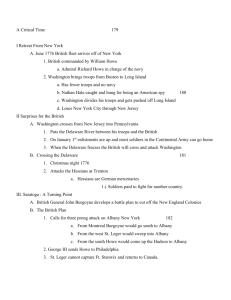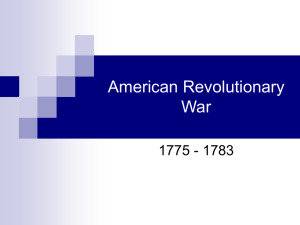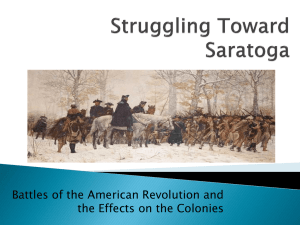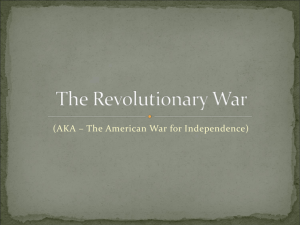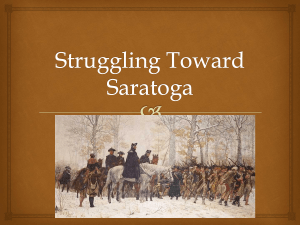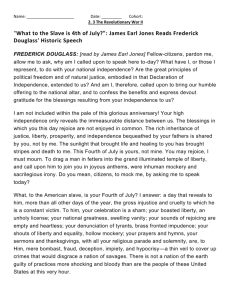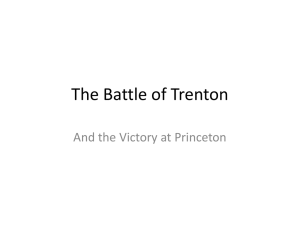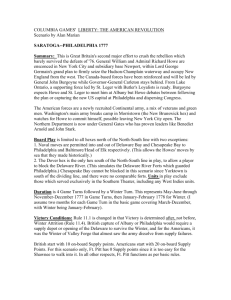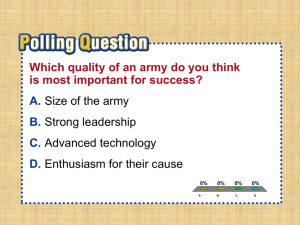The Revolution - MsLeonardsUSHistoryI
advertisement
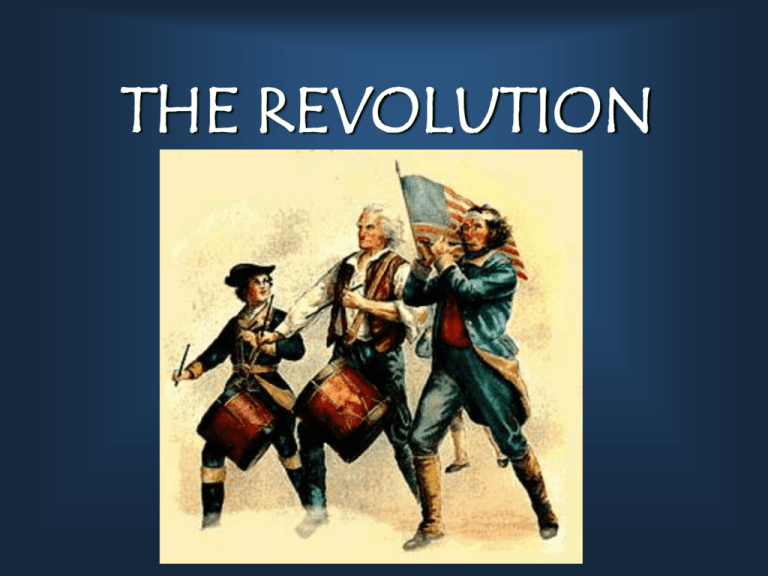
THE REVOLUTION The Early Years of War Deciding on loyalties Strategies of war The War Expands Help from Abroad Fighting on Different Fronts The Path to Victory The South and the Backcountry The Legacy of War Americans Divided – which side to support Loyalists, Patriots, and Neutrals No one knew how a war with England would end No one could know what would result after the war Patriots – New England & Virginia Loyalists – cities such as New York & in the South Split families because some members took side of Britain, while others were patriots Others Native Americans – took sides Some to save their land; others because interacted w/ colonists African Americans – generally not allowed to enlist Some chose to fight for the British Neutrals – people who thought the war was a bad idea Chose to not take sides Creating an Army (How to face the British) George Washington – Commander-inChief Challenges Small army – 17,000 men or fewer Limited-time enlistment Lack of previous training/experience Lack of supplies – shoes, food, guns & ammunition Benefits (Advantages for the Colonists) Fighting for own land/nation British/Hessian soldiers on foreign soil Help from other quarters – women, locals, etc. Women cooked & cleaned for soldiers & tended the sick Molly Pitcher Deborah Sampson Over-confidence of the British Struggle for the Middle States Control of Boston assured by March 1776 British Strategy William Howe (Commander-in-chief of British forces) Along with his brother Admiral Richard Howe (navy) he hoped to defeat the Patriots Blockade of American ports Mercenaries from Germany Focus on Middle Colonies Washington thought that’s what the British would do Why? To cut off northern colonies from southern ones Divide and conquer July 1776 – British arrive with 30,000 soldiers in New York Struggle for the Middle Colonies British march against Colonial forces – colonists panicked, fled Washington frustrated but refused to give up; chose to retreat and regroup Howe spent a month setting up his camp & solidifying his troops’ position Gave Washington time to retreat to Pennsylvania Troops were lacking basic supplies Morale was low Most would go back home on 31 December Winter Quarters & Winter Victories Washington needed to make the most of the training he had given to the troops before they departed for home Knew that there was a garrison of Hessian Troops in Trenton, New Jersey Wouldn’t be expecting an attack so soon after Christmas celebrations Late on 25 December 1776 – crossed the Delaware River Americans captured 900 prisoners (900 less people to fight against) and a good amount of supplies Half the troops stayed on in January & won another victory at Princeton, NJ Helped to attract new recruits to the colonial army The war was affecting everyone within the colonial society as a bloody struggle on their doorstep in terrible inflation that upset normal trade patterns in a general scarcity of goods Benjamin Franklin sent to France in December 1776 To ask for help from French government Charmed the French & got them to eventually become allies with the Americans British Strategy of Divide & Conquer Burgoyne’s New York Campaign (Summer 1777) Three-Pronged attack 1. Burgoyne south from Canada 2. St. Leger east from Lake Ontario 3. Howe north from New York City All to meet up in Albany, having defeated colonial forces on the way Problems with the plan British didn’t know the terrain Misjudged Native American support Did not really tell Howe about the plan Burgoyne’s part of the plan Marched from Montreal to Ft. Ticonderoga Able to easily take the fort American forces were concentrated elsewhere As soon as he turned southward, word went out among the patriots that he was coming Ethan Allen and the Green Mountain Boys “Now let all New England turn out and crush Burgoyne” Burgoyne probably should have turned back, but he refused to give up Plus he thrown parties for each of his earlier victories, slowing down his army’s progress St. Leger’s part of the plan To march from Lake Ontario eastward to Albany Found it difficult to get full support from Native Americans in spite of the efforts of Joseph Brant General Benedict Arnold was able to spread rumors that the American force was very large St. Leger believed he would be outnumbered, so he decided to retreat rather than face defeat Left tents and other supplies behind General Howe’s part of the plan Was supposed to march north from NYC Instead he marched south to try to capture George Washington and then to Philadelphia Commander of Colonial forces Continental Congress Unable to capture Washington, but did take control of Philadelphia Never attempted to march to Albany, meaning Burgoyne was going to have to attack Albany and then defend his position alone Meanwhile, back with Burgoyne … (Aug. 1777) Burgoyne’s forces were running out supplies Sent a raiding party into Vermont Defeated by colonial troops at Bennington He probably should have given up, but he refused Continued to try to reach Albany Found himself facing the Colonial Army under command of Horatio Gates near Saratoga British suffered many losses, and finally had to retreat (role of Benedict Arnold) Battle of Saratoga (October 1777) Complete defeat of the British forces Burgoyne forced to surrender Turning point in the war Great boost in colonial troops’ morale Showed the colonists that they could win major victories against the British Troops could have gone home for the winter, but chose to stay with Washington at his winter quarters Harsh weather conditions Very low on supplies (blankets, food, clothing, fuel for heat, tents) Washington had to convince the Continental Congress that the wasn’t over, that he needed them to send more troops and more supplies Spring 1778 will bring positive changes for the patriots
